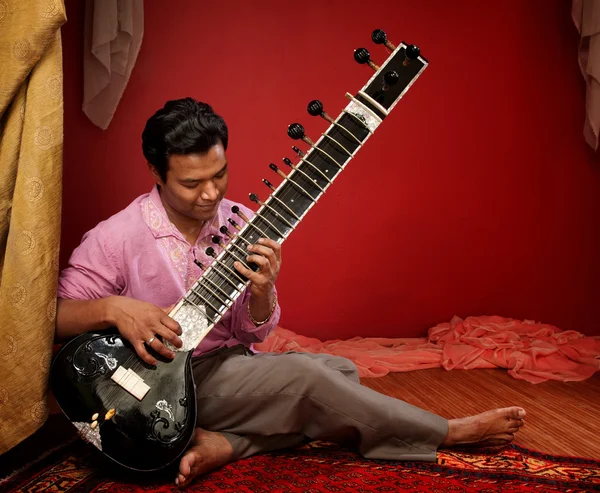Originating in India, a sitar also known as a Vada, is played in the sitting position. The sound box rests on the musician’s foot and the instrument is held so that the neck runs diagonally and upwards in front of the player’s body.
How it’s played
The playing strings that run over the bridge are plucked by the right index finger by using a wire plectrum that is placed on the finger. The sympathetic strings are not plucked but vibrate when melody strings are played. The left hand plays the melody by pressing down on the frets and pulling sideways also known as fingering. The Sitar is very difficult to play and can take as long as five years to understand the basics and play some songs. It is common used while playing Hindustani, Northern and Central India and Pakistan, classical music.




Who Invented it?
There are two modern sitar styles: the Ravi Shankar style and Vilayat Khan style. The Ravi Shankar version has two sound boxes and a lot of ornamentation. This style has 13 sympathetic strings, three drone strings (chikari) and four melody strings. The Vilayat Khan version has only one sound box and faith ornamentation. This style tends to be equipped with 11 sympathetic strings, four drone strings, and two melody strings.
There are conflicting stories as to the history of the sitar. Some scholars believe the sitar developed from the ancient Rudra veena, a large plucked string instrument used in Indian classical music. Other scholars believe the sitar is derived from the Saraswathi veena, an ancient Indian plucked instrument named after the Hindu goddess Saraswathi. She was often depicted in art and literature playing the instrument.
It is not clear who the exact inventor is. Some scholars attribute the invention to Khusrau Khan in the 18th century others say it was invented by a fakir, a Muslim or Hindu religious ascetic, named Amir Khusru.
How it’s made
The sound box of the sitar is made of a pumpkin and the sound board and neck are made of teak wood. Steel or bronze strings run over two curved bridges. Most sitars are decorated with lavish carvings. A sitar can have as many as 20 strings! Some strings are played and the remainder act as “sympathetic” strings which run under the played strings. Of the two curved bridges, one is for the played strings and the other for the sympathetic strings.Have a listen!
Here is musician Indrajit Banerjee demonstrating the beautiful sounds that a sitar can make.
Learn more about Indrajit Banerjee
Born in a musical family, award winning Indrajit Banerjee was inspired by his mother and trained by his grandfather and uncle. He loves teaching and has a following around the world.

